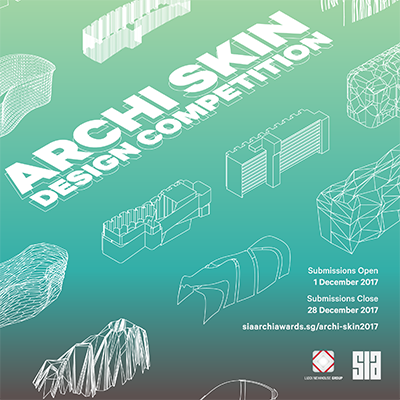An Architectural Competition is a good way to obtain the best design for certain projects. The benefits to the promoter of the competition are innumerable. The project would benefit from the creative minds of many architects, driven by the knowledge that they will have to produce their best work through a transparent evaluation/selection systems to have a chance of winning the competition.
The Singapore Institute of Architects (SIA) has the ability and capability to organise open competitions in compliance to the SIA Competition Guidelines.
The competition, as far as possible, must be open and should be conducted in accordance to the SIA Competition Guidelines so as to benefit both the promoter and participants and achieve a win-win situation for all and in the process further enhance the built environment for the enjoyment of the public.
In the interest of constantly improving the quality of design, Architectural services and the built environment, these competitions must adhere to the following principles in order to realize and achieve the above objective.
PRINCIPLES
StrategicTo serve national good in eliciting innovative design ideas that will help in promoting good architecture and design and consequently a better built environment. It also uplifts the status of the profession, which will then further promote and encourage the development of new exciting and ground breaking design ideas for the good of both the promoter and the public. Operational
This is a consequential follow up from the strategic level as the end tangible result of a competition leads to procurement of innovative design and architectural services. In order to ensure that the competition is successful and that the promoter will enjoy the best design for his building in terms of meeting his functional needs as well as a very high level of architectural design, competitions must adhere to the following principles in order to realize and achieve its objective.
In order to bring this about, certain prerequisites are necessary: –
- A good building brief that sets out the purpose of the building, the client’s aspirations and the detailed description of the functional aspects of the required accommodation. This is very important, as unlike a conventional project where the architect can dialogue with his client to produce the building brief, competitions brief taking must be done professionally as the competitors will be solely reliant on it to carry out their designs.
- Professional advice is also required in order to establish the constraints of the site in terms of planning and other Authority requirements as well as cost constraints. This professional advice will ensure that promoter will be able to achieve design submissions that are appropriate for his site and buildable within his budget.
- Qualified judges are essential to the success of the competitions. The selection of the best and most appropriate design is the responsibility of the judges. The quality of the judges is especially important for open competitions as participants will only risk spending their effort when they have the confidence that the judges will be able to evaluate their submissions properly. In international competitions, it is virtually a necessity that there would be world renowned architects sitting in the judging panel.
- Anonymous submission and selection is another important element as this ensures a level playing field where the judges would not be influenced or prejudiced for or against any scheme because of the identity of the author. Anonymous submission ensures that the selection would be based solely on merit and will ensure that the promoter will have a worthy winning design.
The foregoing prerequisites require that an architect advisor be appointed to manage the competition. This is detailed hereinafter.
Architectural design competitions conducted in accordance to SIA Competition Guidelines
- Proposed Development of St John’s Home for Elderly Persons
- Wisma Geylang Serai Design Competition
- Bukit Panjang Hawker Centre
- Punggol Mosque
- Indian Heritage Centre
- Al-Ansar Mosque
- Tampines Town Council Neighbourhood Renewal Program
- Stadium & Museum Stations
- NUS Alumni Complex
- scape*
- Maybank Chambers at Battery Road
The SIA Gold Medal is the highest honour the Singapore Institute of Architects bestowed on a senior architect, in recognition of his life time contribution to architecture and his most distinguished service to the profession of architecture. The senior architect bestowed with this Award would have attained a respectable standing in society and has made sustained and substantial contribution to architecture and the profession.
The Medal was introduced at a point in Singaporean architectural history when many of the first generation of architects who had pioneered the profession in Singapore was nearing retirement age, and the Institute believed that it was then appropriate to confer an honour on those who had contributed significantly to architecture during their lifetime. It was a time when Singaporean architecture could be said to have come of age; a period when there was a time frame and body of work with which to judge those who had made a sustained and substantial contribution to architecture in Singapore.
The Medal is conferred on a different architect once every two years and the first SIA Gold Medal was conferred in 1998. To give the honour the prestige it deserves, only one architect is conferred in each occasion. The Medal is modelled on RIBA’s Royal Gold Medal, which was instituted by Queen Victoria in 1848.
To receive the SIA Gold Medal, the nominee has to have demonstrated through his work that he has fulfilled three principal criteria:
- He has achieved a sustained and substantial body of work of architectural excellence and that either directly or indirectly he has promoted the advancement of architecture.
- He has attained a respected professional standing in society, with personal integrity, and that he may be considered an ‘ambassador’ for the profession.
- He has demonstrated leadership qualities that provide direction and enhancement for the prestige of the architectural profession, as well as serving as a role model that will inspire other architects.
The selection of the recipient is through nomination by SIA members who have to provide supporting evidence for the suitability of the person being nominated. An Awards Committee comprising eminent persons and architects within the profession then evaluate the candidates before endorsing one recommendation. The person nominated for the award is required to give a lecture that focuses on a review of his work and achievement.
The AwardThe award consists of a crystal sculpture designed by Singaporean artist Min Chen, and is made in Germany by experienced glass blowers. On the sculpture are the words ‘SIA Gold Medal Award for Life Time Contribution to Architecture’. On the box in which the award is stored is a poem by Min Chen inscribed on a metal plate. A tribute
He is come of age but Ageless
True but mysterious
His internal space informs his facade
This is a tribute to one man
Whose finite achievements transcend the apparent
A man of many faces, many profiles
But still all one man
One man whose grace and subtlety give
Substance to our touch;
One man whose destiny it is to have
His spirit forever reside within our hearts SIA Architectural Design Awards
Organized by SIA, the SIA Architectural Design Awards is the most prestigious award implemented by SIA to promote and encourage excellence in architectural design. The intention is to recognize the efforts of SIA members in their pursuit of architectural excellence and innovative solutions. It is also aimed at heightening the appreciation and patronage of good architectural design from both the architectural fraternity as well as the general public. It is the Institute strategic intent that the Awards will motivate architects to strive for higher standards of architectural excellence and imbue with the relentless mindset of continually achieving great heights, leading to the vision of Singapore architecture being accepted as world class standards.
The Awards was inaugurated in 1983, in conjunction with an exhibition and conference under the theme, “The Role of the Singapore Architects in the 80s and Beyond”.
| Year | Cycle | No of entries / No of firms |
Design Awards |
Honourable Mentions |
||||
| 1983 | 1st Awards | – | 14 | 15 | ||||
| 1987 | 2nd Awards | 160/50 | 9 | 23 | ||||
| 1991 | 3rd Awards | 172/32 | 6 | 26 | ||||
| 1995 | 4th Awards | 104/35 | 7 | 14 | ||||
| 1998 | 5th Awards | 183/58 | 9 | 6 | ||||
| 2001 | 6th Awards | 196/61 | 15 | 31 | ||||
| 2003 | 7th Awards | 119/46 | 5 | 17 | ||||
| 2006 | 8th Awards | 164/55 | 15 | 27 | ||||
| 2008 | 9th Awards | 157/50 | 7 | 12 | ||||
| 2010 | 10th Awards | 181/51 | 11 | 18 | ||||
| 2011 | 11th Awards | 160/56 | 9 | 18 | ||||
| 2012 | 12th Awards | 112/53 | 10 | 12 | ||||
| 2013 | 13th Awards | 110/40 | 14 | 7 | ||||
| 2014 | 14th Awards | 105/48 | 14 | 10 | ||||
| 2015 | 15th Awards | 93/49 | 6 | 8 | ||||
| 2016 | 16th Awards | 91/38 | 13 | 14 | ||||
| 2017 | 17th Awards | 105/44 | 4 | 5 | ||||
| 2019 | 18th Awards | 117/51 | 6 | 15 | ||||
| 2020 | 19th Awards | 104/54 | 20 | 11(merit) |
The Prize was launched by the Singapore Institute of Architects and Getz Bros. & Co. (Singapore) in 2005. To date, the award has drawn entries from over 10 countries within Asia including China, Japan, India, Thailand, Singapore, Indonesia, Vietnam, Pakistan, Taiwan and Philippines.
The laureates for 2006, 2008 and 2010 are Mr Chan Soo Khian (Singapore), Dr Hitoshi Abe (Japan) and Mr Wong Mun Summ & Mr Richard Hassell (Singapore).
http://www.sia-getzarchprize.com/
Purpose
The biennial SIA-Getz Architecture Prize for Emergent Architecture in Asia honours an architect who has significantly contributed to the progress of architecture in Asia. In the last decade, Asia has seen an overwhelming rate of development, and this is beginning to have an impact upon the history of architecture as well as its future. It is therefore timely to recognise and promote emergent Asian architects and architecture, much as the Pritzker Prize has for the worldwide community of architects.
The Prize aims to:
- Increase recognition of emergent Asian architects and architecture
- Increase public involvement and appreciation of Asian architecture
- Encourage future generations of Asian architects
- Honour a living architect and to recognise a career in progress
About the organisers


